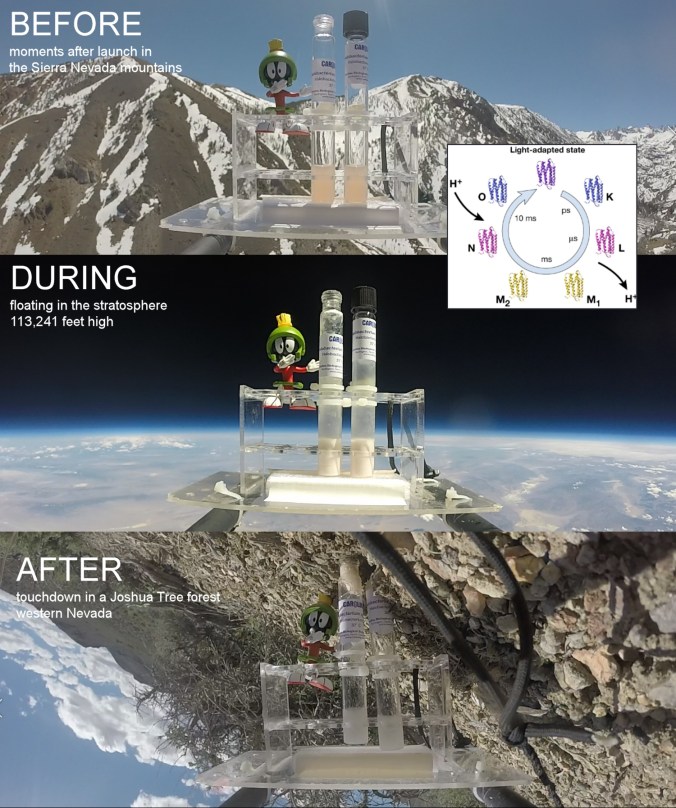June 13, 2019: Picture this: An astronaut climbs aboard his spacecraft and blasts off from Earth. At the apex of the flight, he experiences something strange. Weightlessness? Space sickness? No. He changes color! This doesn’t happen to human astronauts, but it does happen to halobacteria, an extreme-loving microbe from Earth that might be able to live on Mars.

In recent weeks, Spaceweather.com and the students of Earth to Sky Calculus have been flying halobacteria to the stratosphere. Why? To see if the salt-loving microbes might be able to survive on the Red Planet. The stratosphere is a good place to find out because conditions in Earth’s stratosphere are remarkably similar to conditions on the surface of Mars.
The quick answer is YES. Halobacteria do survive–for brief trips, at least. Halobacteria that we launch into the stratosphere come back alive a few hours later, and we can easily culture them in an incubator.
But they don’t come back unchanged. We find that halobacteria color-shift during their trip to the edge of space. On Earth, they’re pink. When they reach the stratosphere, they turn yellow–and they remain yellow even after they return to the ground. Just by looking at the color of a sample, we can tell if it has been to the stratosphere.

The many colors of halobacteria. The yellow varieties have all flown to the stratosphere. The pinkest forms are descendents of the yellows.
Back in the lab, something even more interesting happens. When we culture the “space-traveling” yellow halobacteria, allowing them to feed and multiply, their descendants turn pink again! The descendants undo the effects of the balloon flight, resetting themselves for another trip.
What’s happening? The answer involves bacteriorhodopsin.
Bacteriorhodopsin is a protein used by halobacteria to help feed themselves When food sources become scarce, halobacteria photosynthesize sunlight for energy. Unlike plants, however, they don’t use green chlorophyll. Halobacteria use purple bacteriorhodopsin.
 Bacteriorhodopsin has two stable forms–a purple form and a yellow form, each with a different shape. During photosynthesis, bacteriorhodopsin toggles back and forth between these forms, blinking yellow and purple. Because of this color-shifting ability, technologists have long been interested in using bacteriorhodopsin as a kind of “electronic ink” in tablets and smart phones.
Bacteriorhodopsin has two stable forms–a purple form and a yellow form, each with a different shape. During photosynthesis, bacteriorhodopsin toggles back and forth between these forms, blinking yellow and purple. Because of this color-shifting ability, technologists have long been interested in using bacteriorhodopsin as a kind of “electronic ink” in tablets and smart phones.
When we launch halobacteria to the stratosphere, the microbes turn yellow–and stay yellow. They stop cycling back to their purple state as they would normally do during photosynthesis. Perhaps UV rays in the stratosphere denature the bacteriorhodopsin proteins. Denaturing means they lose their shape, permanently changing their color.
Whatever causes the color change, the descendants of flown halobacteria put their proteins back together again–ready for more trips to space.
We’re preparing to fly a batch of the descendants to see if they are even tougher than their predecessors. Stay tuned